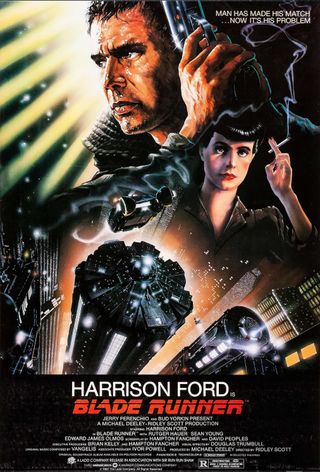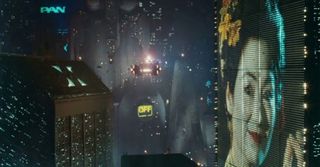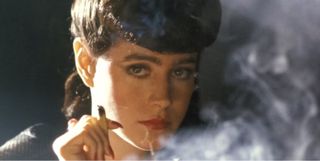It’s a daunting task to imagine a more pivotal year for classic Hollywood genre films than 1982. Trek II: Wrath of Khan, “The Thing”, “ET the Extra-Terrestrial”, “The Dark Crystal”, “Tron”, “Conan the Barbarian”, and director Ridley Scott’s neo-noir gem, ” Blade Runner”.
Warner Bros.’ ‘Blade Runner’ opened on June 25, 1982 to mediocre reception upon release and was far from the influential masterpiece that is now considered one of the greatest sci-fi films of all. the temperature. Its dystopian story of a future 2019 Los Angeles that has become a crumbling megalopolis and its team of anti-android assassins was adapted from award-winning author Philip K. Dick’s 1968 novel “Do Androids Dream of electric sheep? (opens in a new tab)Here’s our streaming guide for the Blade Runner franchise if you need to catch up.
Starring Harrison Ford, fresh off filming “Star Wars: The Empire Strikes Back” and “Raiders of the Lost Ark,” “Blade Runner” told the story of Rick Deckard, a haggard detective assigned to the Blade Runner team to retire. ‘synthetic humans on Earth after being declared illegal, except for use in off-world colonies where they were deployed as slave labor.
Built by the infamous Tyrell Corporation, these advanced robots called Replicants were identical to humans and the tech company had currently advanced its product to the NEXUS-6 advancement stage. When a team of six replicants slaughter a shuttle crew and return to Earth, the roundup of thugs is launched and the bounty hunter is ordered to track down the surviving quartet.
“Blade Runner” co-starred Rutger Hauer as battle replicant Roy Batty, Daryl Hannah as Pris, a sex-bot android, Joanna Cassidy as Zhora, Brion James as Leon, and Sean Young as the charming Rachael, a Nexus-7 model embedded with false memories to provide emotional cushion.
Mr. Emmet Walsh portrayed Deckard’s boss, Captain Bryant, and Edward James Olmos played Detective Gaff, another Blade Runner who knew the truth about Deckard.
Related: Real “Replicants”: 6 humanoid robots used for space exploration
As Scott’s next project after “Alien” in 1979, the visionary filmmaker turned to a screenplay written by David Peoples and Hampton Fancher, whose producer friend Brian Kelly had opted for Philip K. Dick’s book. The effort had immediate appeal for Scott as he believed it would provide the perfect canvas for a pioneering science fiction film filled with provocative material about mortality, the dangers of overextended science, the nature of humanity and an inevitable clash with fringe AI. Technology.
Saturated in the blue haze of cigarette smoke, grimy cityscapes and flawed downtrodden characters that inhabit classic crime thrillers from authors like Dashiell Hammett and Raymond Chandler, “Blade Runner” reinvented the cerebral sci-fi movies of in a way that remains both elusive and illuminating.
Ridley Scott’s exquisite world-building, dark tone, and imaginative production design in “Blade Runner” are legendary, and this neon-splattered hell with perpetual acid rain drenching the crowded urban blight and flying cars zooming overhead of decadence has been the visual standard for most sci-fi movies and dark video games ever since.
Related: ‘Blade Runner: Black Lotus’ Marks New Sequel Miniseries From Titan Comics
That’s a remarkable legacy on its own if it weren’t for the myriad other influences and inspirations that film has provided to generations of artists, designers, and filmmakers. An impressive payoff is that it’s the first major film to delve into what would later be coined by “Neuromancer” author William Gibson as cyberpunk.
Fortified with a transcendent electronic score by Greek composer Vangelis, groundbreaking optical effects, models and miniature artwork from Douglas Trumbull’s “2001: A Space Odyssey,” and lush cinematography courtesy of Jordan Cronenweth, “Blade Runner” is a true revelation to behold.
Hauer’s memorable “Tears in Rain” speech on the rainy rooftop with Deckard before he expired is one of the most indelible moments in cinematic history. Its lines were written by screenwriter David Peoples and edited at the last minute by Hauer himself. Rumors have confirmed that the crew members watching the shoot that day were a bit hazy after the death monologue and we don’t blame them for a single tear.
One controversial aspect of the theatrical release that was discussed ad nauseam is Harrison Ford’s Deckard voiceover in response to nervous studio executives who feared audiences couldn’t follow the plot. Ford apparently gave an intentionally flat reading of this harsh dialogue perhaps as a revolt against the addition, but perhaps just to emulate that kind of deadpan delivery heard in vintage Hollywood detective films.
The funny and unnecessary voice-over was thankfully removed in “Blade Runner: The Director’s Cut” in 1992. (opens in a new tab)and Deckard’s unicorn dream sequence was added, confirming that the bounty hunter was indeed an experimental replicant when paired with Gaff’s telltale origami unicorns. But this version also uses a happy ending with Deckard and Rachael spinning above the countryside in a Spinner flying car.
By far the most comprehensive variant, and Scott’s favorite, is 2007’s “Blade Runner: The Final Cut”. (opens in a new tab)which has been remastered for picture and sound as part of the film’s 25th anniversary. This version removes the happy ending and voiceover, retains the unicorn sequence, adds a reshot stunt scene from Joanna Cassidy’s Zhora and allows Roy Batty to release his dipped white into a darkened sky instead of daylight.
Denis Villeneuve’s 2017 sequel “Blade Runner: 2049” was a fine companion piece to the original film that respected its legacy and was carefully crafted to fit in with Scott’s masterpiece.
On its 40th anniversary today, it’s satisfying to know that “Blade Runner” is still being dissected and discussed as the quintessential sci-fi art film, one that delves into the mysteries of creation and its inherent responsibilities as humanity strives to avoid extermination in the wake of advances in soul-destroying machine technology.
With ‘Blade Runner’, Sir Ridley Scott conjured up a meditative mood and a dystopian dream for the whole world to ponder and it’s quite an amazing achievement to be hailed after four decades. Not bad for the only third film by the British filmmaker!
For more speculative fiction classics, check out our list of the best sci-fi movies of all time.
Follow us on twitter and on Facebook.
 Jenam 2011
Jenam 2011

